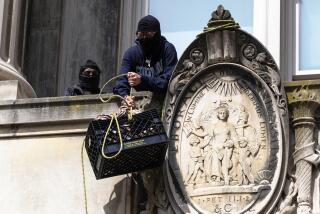Columbia S&L; to Refund Early-Withdrawal Fines : Thrifts: Depositors had forfeited interest if they took their funds out in the wake of the firm’s insolvency declaration.
Ailing Columbia Savings & Loan, trying to lure back nervous customers it lost last week after disclosing that it is insolvent, is offering to credit depositors with interest they forfeited when they closed their accounts early.
In a letter to customers, Abraham Spiegel, chairman of the Beverly Hills thrift, offered to credit interest lost if savers redeposit their money within one month.
The offer is unusual but not unprecedented. Authorities said similar strategies have been used by other institutions that experienced unusually heavy withdrawals after releasing bad financial news or after being seized by regulators.
Still, Columbia would be one of the biggest thrifts to resort to such methods. Furthermore, the move clearly shows some concern about maintaining the thrift’s liquidity--its ability to meet demands of depositors withdrawing their funds.
Sources unaffiliated with Columbia described the outflow of deposits during the past two weeks as “moderate,” probably close to $150 million. Its total deposits stood at about $7.8 billion as of Dec. 31.
They added that regulators did not consider the outflow last week to be significant enough to cause any liquidity concerns, adding that Columbia was not forced to borrow money from the Federal Home Loan Bank of San Francisco to meet its needs.
Withdrawals have since slowed, they said. One reason why the deposit outflow was not especially severe is that the bulk of Columbia’s deposits--about two-thirds as of Dec. 31--were from sophisticated money brokers who deposit money for institutional investors at thrifts offering the highest yields.
The withdrawals started after Columbia disclosed on April 1 that it lost $575 million in a recent five-month period. Columbia’s losses were caused largely by the plunge in the value of its $3.38-billion collection of junk bonds, which are risky, high-yield bonds issued by corporations with poor credit ratings. The rapid deterioration in the value has wiped out the financial cushion Columbia must maintain to protect against losses and dropped its value to its stockholders to a negative $121 million.
Being insolvent also puts Columbia perilously close to being seized by regulators. The thrift is scrambling to find a buyer for its junk bond portfolio, a sale it must make if there is even the slimmest chance for survival as an independent institution.
The withdrawal problem at Columbia shows how fragile public confidence is in the S&L; industry lately even though the federal government guarantees deposits up to $100,000. At many institutions, confusion and hysteria has often been touched off by bad news to the point where some customers withdraw accounts and forfeit interest they earned even when they are in no danger of losing their money.
Withdrawal penalties can be steep. At Columbia, the penalty for early withdrawal of a CD that matures in two to five years is a full year’s interest. The penalty is six months’ interest for a one-year CD.
Despite its problems, Columbia still is aggressively attracting deposits. The rates Columbia pays depositors are among the highest in California but remain within guidelines it must follow under last year’s federal thrift bailout law.
Under that law, as of Feb. 6, a troubled S&L; cannot solicit depositors by offering “significantly higher” than what competitors are offering in its area. A Columbia spokeswoman said that is defined as 0.5 percentage points above what its competitors generally offer and that the thrift is within those guidelines.
More to Read
Inside the business of entertainment
The Wide Shot brings you news, analysis and insights on everything from streaming wars to production — and what it all means for the future.
You may occasionally receive promotional content from the Los Angeles Times.










